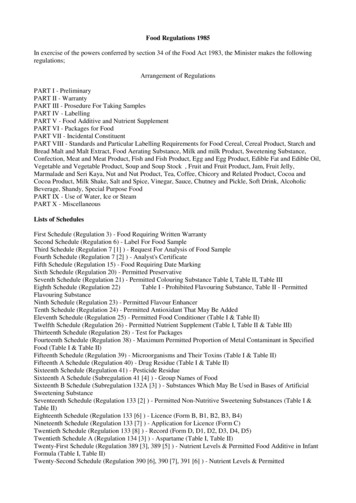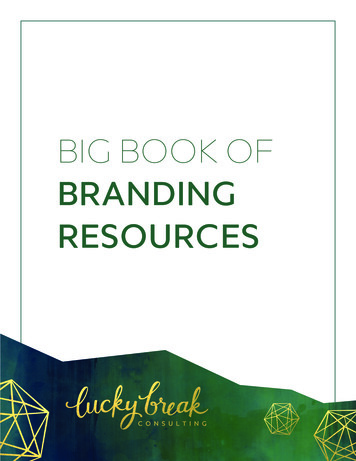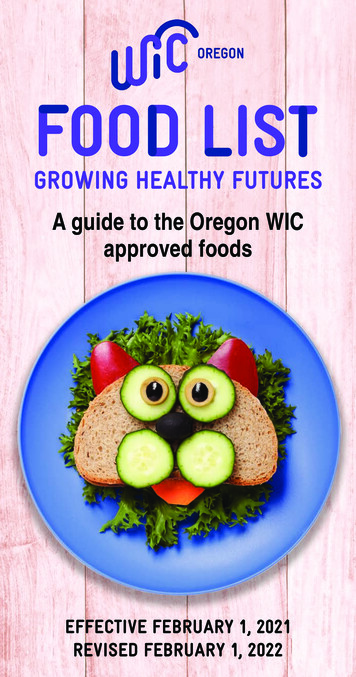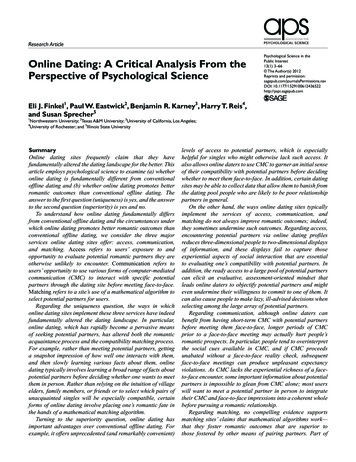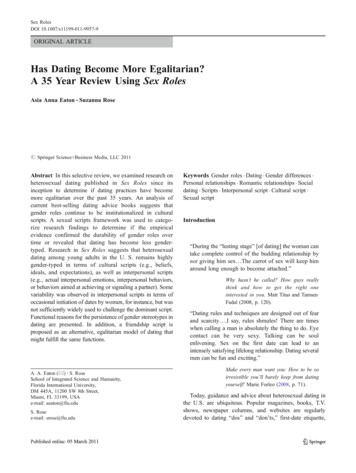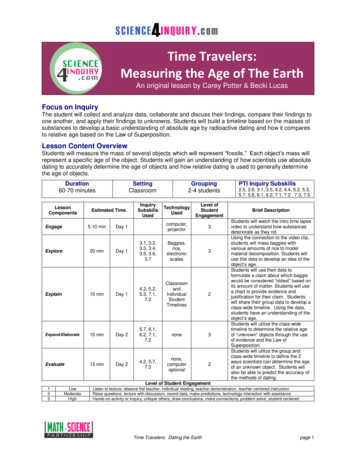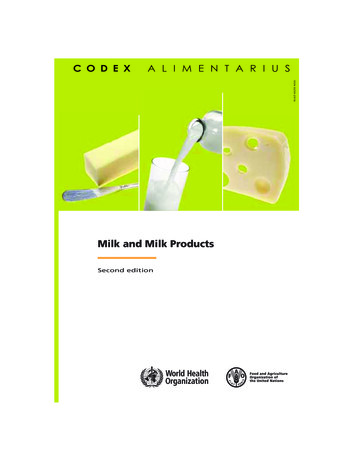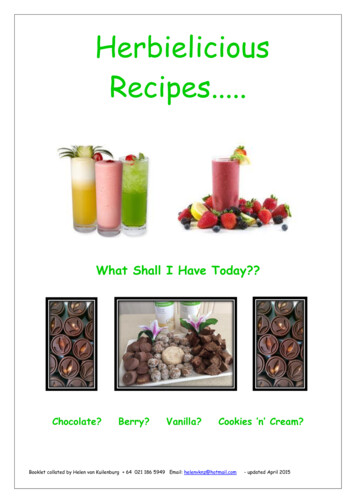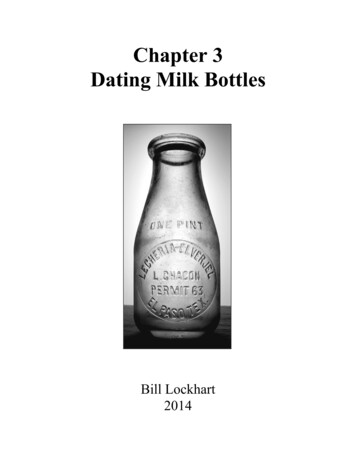
Transcription
Chapter 3Dating Milk BottlesBill Lockhart2014
Chapter 3Dating Milk BottlesBill Lockhart 2014[Most of this chapter was originally Published in Lockhart (2011).]The basic idea behind dating all bottles follows the same principles. Such generalities asmanufacturing techniques, manufacturer’s marks, and different labeling styles are somewhatuniversal. Because of these similarities, please see Lockhart (2010) or Lindsey (2014) forgeneral dating techniques. This chapter will be devoted to dating issues that relate only to milkand dairy containers.The archaeological community has been notably silent on the subject of dairy containers.Jones and Sullivan (1989), the accepted authority for glass terminology contains no category formilk bottles and very little information specific to dairy containers except a brief description ofdisc closures (see below). Because milk bottles are usually associated with 20th centurydeposition (with occasional late 19th century containers found in northeastern contexts), littleresearch appears to have been generated.Initially, milk was delivered in cans stacked upright in a wagon (see Figure 1-1). At eachstop, someone (usually the wife of the house) would bring a pitcher or a pail to the wagon, andthe milk man would ladle out the desired amount of milk. Needless to say, this practice washazardous and unhealthy. The New York State Tuberculosis Association condemned thepractice of selling “loose milk,” still being conducted in New York City in 1922, as a majorcause for the spread of tuberculosis (Glass Container 1922:8). It is probable that the delivery ofmilk in glass containers became universal shortly thereafter.I originally intended for the dating section to be a single chapter, but the information wasso vast and required so many graphics to support it that I have divided it into two chapters. Inaddition, because the topics of finishes and closures are so complex, I have given them their ownchapter (Chapter 3). They are both certainly part of the manufacturing process, and they arehighly instrumental in assessing dates of both individual bottles and archaeological assemblages.19
Milk Bottle Design ChangesEarly Milk JarsTutton (1994:3) stated that the Lester Milk Jar was patentedJanuary 29, 1878. A screw clamp held the lid in place, but the entirecontainer was awkward. Knipp (1999:4) noted that some of the jarswere patented “Nov. 16, 1868,” along with other patent dates ofOctober 9, 1877. He also presented evidence that the jar was used untilat least 1881 and possibly until 1888. Knipp also observed a logoembossed on the body of the bottle that he translated as LMCo for theLester Milk Co. The Dairy Antique Site (2014) added that the bases ofthe jars were embossed “LESTER MILK CO.” and the LMCO initialsare on the lid.Figure 3-1 – WarrenMilk Jar (Courtesy DaleMurschell)In 1879, the Warren Glass Works beganadvertising the Warren Milk Jar in New York City. The Whitemanbrothers – owners of the firm – moved the plant to Cumberland,Maryland, the next year and concentrated on milk jar production. Allof their jars used variations on what has become known as the tin-topclosure (Figure 3-1; also see closure section). The Whitemanscontinued production into 1891, although A.V. Whiteman continued tohave the bottles made by other glass houses and sold them from hisNew York office until at least 1904 (Gallagher & Munsey 1969:331;Schulz et al 2010:46-57; Tutton 1994:4).Harvey D. Thatcher of Pottsdam, New York, offered the publica bottle embossed “Thatcher Milk Protector” between 1884 and 1889.This bottle was another tin-top, following the basic lightning closureFigure 3-2 – ThatcherMilk Protector(Courtesy AmericanGlass Auction)style (Figure 3-2). By 1885, Thatcher was advertising his milkprotector as “the ONLY PLAN KNOWN that secures to the consumerABSOLUTELY PURE MILK in such manner that it can be kept sweetfor several days, furnish a good coat of cream and is handy to use. . . .20
THE SEALED BOTTLES are easy for the patron to store as they can be kept in a refrigerator[icebox] without imbibing its odor” (Tutton 1994:8).Two of his associates, however – Harvey P.Barnhart and Samuel L. Barnhart – patented the“common sense milk jar,” which used the cap seat andligneous disk as a seal, on September 17, 1889 (PatentNo. 411,368 – Figure 3-3). Although a number of otherpatents for variations would follow, the delivery ofbottled milk became practical because of the Barnhart’sinvention – sold by the Thatcher Mfg. Co. (Gallagher andMunsey 1969:332; Lockhart et al.2007:53-55;Scharnowske,1998:6; Tutton 1997:6). The containerbecame so popular that Thatcher was called the father ofthe milk bottle.Late-19th century milk containers were made in avariety of sizes, styles, and finishes. These werefrequently embossed with the name of the dairy that usedthem and at least a partial address. Closures were madeFigure 3-3 – Banhart brothers patent forthe Common Sense Milk Bottlefrom glass or metal, and, of course, the ligneous (latercardboard) disk that eventually made all other closures obsolete (Tutton 1997:6-7). Most pre1900 milk bottles were used in the eastern section of the U.S.Fruit Jars Used for MilkKnipp (1998:2-3) presented his commentary on and excerpts from a January 1880 treatiseby Dr. J. Cheston Morris, entitled “On the Method of Milk Shipment in Glass Jars”:The use of the Cohansey fruit jar (quart size) was promoted as an improvement tothe method of delivery and quality of the milk. “The milk is drawn off into quartjars, each jar is closed and sealed with the name of the producer and date ofshipment . . . . Twenty of the jars are packed in a box and are ready for shipment21
to the customer.” In warm weather, some jars were filled with ice. Dr. Morriscontended that is [sic] this manner the customer gets the real article furnished bythe producer and not altered by the milkman.Knipp further noted that “pint Cohansey jars were used (in later years)by Echo Farm and the Deerfoot Farms of Mass” (Figure 3-4).The Dairy Antique Site (2014) also reported the use of Cohanseyjars by Deerfoot Farms, Southborough, Massachusetts, as well as otherdairies and the use by some of the Crystal jars, Pet fruit jars, andPutnam’s Lightning jars. The Cohansey Glass Mfg. Co., Bridgeton,New Jersey, was open from 1869 to 1900, when the plant was moved toDowningtown, Pennsylvania, and the name was changed to theCohansey Glass Co. The plant closed permanently in 1911.Figure 3-4 – Cohanseyjar (eBay)Common Sense Milk BottlesIn 1889, H.P. and S.L. Barnhart, employees ofHarvey Thatcher, Potsdam, New York, patented the“Common Sense Milk Bottles.” The finish of thisbottle had a built-in ledge to support a ligneous(cardboard) disk for a closure. These cylindricalbottles had a wide body and fairly wide mouth (Figure3-5; also see Figure 3-3). They became the industrystandard by 1900, replacing the earlier glass top, “tintop,” and other finish types (Giarde 1980:114; Pollard1993:285; Taylor 1972:46). Thatcher’s bottles wereadvertised as “the handsomest, cheapest, and bestmilk bottle ever offered for sale in any market”(Gallagher 1969:50; Gallagher & Munsey 1969:333;Lockhart et al.2007:53-55). By 1902, Thatcher’sbottles normally came with “TO BE WASHED ANDFigure 3-5 – Common Sense milk bottle(Cultivator and Country Gentleman 1895)RETURNED” embossed on the reverse side (Thatcher 1902:3-4).22
Universal Store BottlesAbout 1913, some areas adopted the Universal StoreBottles. These bottles were embossed “STORE / 5 /BOTTLE” and could be sold in stores by any dairy in areasusing the bottles (Figure 3-6). This generic bottle eliminatedthe sorting of bottles according to individual dairies (Walsh1990:3). I have not discovered how long the practice existedor how well it worked.Figure 3-6 – “Store” milk bottle(Owens-Illinois 1930:M14)Cream-Top Milk BottlesOn March 3, 1925, Norman A. Henderson receivedPatent No. 1,528,480 for a “Milk Bottle and Cream Separator foruse Therewith” and assigned it to the Cream Top Bottle Corp.These bottles display a bulbous neck to contain the cream as itrises to the top of the milk (Figure 3-7). Henderson had appliedfor the patent on April 16, 1921, almost four years prior toreceiving the patent. The delay may have been due to earlierbulge-neck patents for otherbottle types. Not surprisingly,the container became known asthe cream top milk bottle (Giarde1980:31).Figure 3-7 – Cream-top milkbottle patentHenderson had includedhis own device for plugging theneck to allow the cream to bepoured off, but Herbert E. Hill invented a special spoon (orseparator), shaped to fit into the bottle neck, that was simple andmore effective at holding back the milk while the cream wasremoved (Figure 3-8). Hill applied for his patent for a“Separator for Milk Bottles” on August 3, 1922, and received23Figure 3-8 – Patent of thespoon for the cream-top bottle
Patent No. 1,506,752 on September 2, 1924, six months prior to Henderson’s bottle patent(Tutton 1994:33). Because of its efficiency, the spoon came into common usage.Ruth M. Clark designed a square version of the cream top. Her design included flattenedsides on the “bulge” and chamfered corners on the square body. She applied for the patent onMarch 2, 1944, well before the date that Owens-Illinois announced its square milk bottle design(see below). Clark received Design Patent No. 136,997 on January 11, 1944, and assigned it toNorman A. Henderson. As may be gleaned from the above, the Cream Top Bottle Corp. was theexclusive manufacturer of this type of bottle until the patents expired. After that, similar bottleswere made by the Illinois Pacific Glass Corp., Pacific Coast Glass Co., Owens-Illinois Glass Co.,Thatcher Mfg. Co. and Lamb Glass Co. See Dairy Antique Site (2014) for more information.Baby Top VariationMichael A. Pecora designed a subtype of cream top thatcame to be called a baby top by collectors. Pecora applied for hispatent on December 2, 1935, and received Design Patent No.98,609 on February 18, 1936 (Figure 3-9). Pecora assigned thepatent to the Pecora Farm Dairy, a partnership composed ofMichael A., Pasqua, and Salvador Pecora. These containers, madein half-pints, tall, tapered half-pints, quarts, and half-gallons,exhibited an embossed baby face on the bulbous neck (Tutton1994:38).Pecora filed another patent on September 3, 1948, for asimilar bottle with two baby faces – on opposite sides of thebulbous neck. He received Design Patent No. 155,834 onFigure 3-9 – Babytop milkbottle patentNovember 1, 1949, and also assigned this one to his family dairy.These bottles survived the change to square morphology as did the regular cream top. Oddly,Pecora also designed a baby-face ice cream cone and received Design Patent No. 109,940 onMay 31 of the same year.24
Pecora formed the Pecora Baby Top Products Co. to sell bottles of this design. This,however, was a distribution firm not a glass house. Various glass manufacturers produced theactual containers. For more information, see the Dairy Antique Site (2014).The Dairy Antique Site (2014) explained that:One difference from the Cream Top milk bottle was that the Pecora Baby TopProducts Company advertised that a cream separator device was not needed withthe Baby Top milk bottle. Simply pouring over the side of the baby’s head wouldresult in the cream being removed. Pouring over the baby’s face would result inwhole milk being removed. The constriction at the baby’s neck was oval ratherthan round like the Cream Top milk bottle. Presumably this difference is whatallowed the cream to be removed without a separator but in reality a Cream TopSeparator Spoon would work quite well and improve the separation of the cream.Cop the CreamA second spinoff was called cop the cream because thebulbous neck on these bottles contained a stern face thought toresemble that of a police officer. Robert C. Gennaro, Vincent L.Gennaro, and Emil L. Gennaro jointly applied for a patent forthis bottle on October 16, 1937, and received Design Patent No.108,074 on January 25, 1938 (Figure 3-10). The bottles weremade in half-pints, pints, and quarts (Tutton 1994:40).The Gennaros formed the Cop the Cream Bottle Co. tovend the bottles. As with the Pecora firm (above), this was asales and advertising concern, not a glass manufacturer. Cop theCream contracted with the Universal Glass Products Co. to makethe containers. See the Dairy Antique Site (2014) for moreinformation.25Figure 3-10 – Cop-the-creammilk bottle patent
Modern TopStill another variation, the modern top milk bottle, wasmanufactured with an elongated bulb and a more constrictedneck (Tutton 1994:41). On November 21, 1936, William C.Teunisz applied for a patent for a “Cream Separator and MilkContainer” – although his description centered around thecream separator (Figure 3-11). He received Patent No.2,112,233 on March 29, 1938. Just as soon as the separatorentered the protected realm, Teunisz applied for a patent onthe bottle – on April 8, 1938 – and received Design Patent No.111,311 on September 13, 1938. He applied for and receivedpatents for one or two additional improvements a year through1943.In 1940, Teunisz designed a cone-shaped milk bottle(Design Patent No. 124,880, January 28, 1941), although itFigure 3-11 – Teunisz ModernTop patentswas apparently unsuccessful. He also applied for anotherpatent on July 13, 1944, this time for a much more popularsquare milk bottle. He received Design Patent No. 139,331 forthe new bottle shape on October 31, 1944. His final bottlepatent was for a specialty (also called proprietary or deco) sodabottle (Design Patent No. 138, 663, August 29, 1944), also anapparent flop. Although Teunisz did not assign his patents toany specific firm, he was apparently involved with the ModernTop Milk Bottle Co., a firm that controlled the rights to thebottle. The company sold a franchise for the bottle to only onedairy in an area, competing with the more established CreamTop bottles. Lamb Glass and Owens-Illinois both made bottlesof this type. See the Dairy Antique Site (2014) for moreinformation.Figure 3-12 – “Toothache” milkbottle patent26
“Toothache” BottleA final variation, called a “toothache” bottle by collectors, had an exaggerated bulge toone side of the bulb (Figure 3-12). This style, however, is only found on square containers(Tutton 1994:44). Emile Sheemaeker applied for a patent for a square milk bottle with abulbous neck that extended to one side on September 12, 1945, and received Design Patent No.146,525 on March 25, 1947. Royden A. Blunt applied for a similar (but slightly different)design on July 24, 1951. He received Design Patent No. 169,959 on July 7, 1953. Blunt workedfor the Buck Glass Co., the firm that manufactured these bottles, although Richer-Pour Bottle,Inc., was the organization that sold the containers. Both firms were located at Baltimore,Maryland, and Blunt was almost certainly associated with Richer-Pour.End of the Cream TopsCream top bottles were used until at least the late 1940sand probably later. According to Gallagher and Munsey(1969:334), the cream top vanished because “homogenizationdid away with the problem of cream rising to the top of thebottle.” Although at least two of the standard cream top bottleswere used in northern New Mexico, only a single half-pint bottle– from the El Paso Creamery Co. – has been identified from thesouthern part of the state (see Figure 9-3).Token Milk BottlesFigure 3-13 – “Token” milkbottle patentOn March 10, 1924, Edwin T. Alexander filed for apatent for a “Milk Bottle” and received Patent No. 1,554,191 on September 22, 1925 (Figure 313). This was the “token” milk bottle with an embossed slot for “a metal or fiber token” (Tutton1997:7). The rational for the container placed the cause for its invention on restaurants. Duringthe 1920s, it was common practice to serve milk to customers in its original bottle. As the cap(often the only company identifier) was removed prior to serving, the token would then specifythe bottler (Tutton 1994:34). As these bottles are quite scarce, they apparently achieved littlepopularity.27
Henry Kart’s BottleHenry Kart designed a unique bottle style and appliedfor a patent on May 21, 1928. He received Design Patent No.78,628 on May 28, 1929. The shoulder of the bottle actuallybegins one-quarter of the way up from the heel, and the gradualshoulder/neck extends the rest of the way to the cap-seat finish(Figure 3-14). Although these bottles do not seem to havegained much popularity, at least one was made in green color(Milk Route 2003:3).Cream SeparatorGeorge E. West invented a cream separator milk bottleFigure 2-14 – Henry Kart’s patentthat was very different from the cream top styles describedabove. West applied for a patent for a “Milk Bottle” onFebruary 15, 1929, and received Patent No. 1,770,093 on July8, 1930. Although the bottle was basically made in thecommon sense style, it became known to collectors as “thebottle with the dent” because of a sharp, horizontal indentationon one side of the body (Figure 3-15). The indented side washeld upward while pouring to trap the cream while allowing themilk to flow freely out of the mouth (Giarde 1980:30). Westassigned the bottle to Cream Separator Bottle, Inc., anothersales firm. The bottles were actually made by the Lamb GlassCo., Liberty Glass Co., Thatcher Mfg. Co. and Reed Glass Co.For more information, see the Dairy Antique Site (2014).Arden “Easy Grip” or “Long Neck” Milk BottlesFigure 2-15 – Cream separator“dent” bottleTroy Darrell Lewis applied for a patent on May 20, 1939, and received Design Patent No.118,500 for a “Milk Bottle” on January 20, 1940. The design had steep shoulders and a long,straight neck. Called the Arden “Easy Grip” or Arden “Long Neck,” the bottle was apparently28
used exclusively by the dairies at Arden Farms, a large,Western, regional dairy (Figure 3-16). Arden used the bottlesfrom 1940 to 1946. The Owens-Illinois Pacific Coast Co.made the containers. The bottles were produced in half-pint,pint, third-pint, and quart sizes (Kammerman 1993:4).Square Milk BottlesNightingaleCharles T.Nightingale invented thefirst milk bottle that wassquare in cross-section.Nightingale applied for aFigure 2-16 – Arden “Easy Grip”milk bottlepatent on August 3, 1896,and received Design Patent No. 29,673 on November 15,1898, for a “Design for a Milk-Jar” (Dairy Antique Site2014; Lockhart et al.2011a:1-2). Note thatNightingale’s patentremained in limbo forover two years and threeFigure 2-17 – Nightingale squaremilk bottlemonths. After the longwait, the bottle was neverpopular (Figure 3-17).Blake-HartOn January 13, 1925, Irva J. Blake and Harry N. Hart(both of Sacramento, California) filed for a patent for a“Bottle” that was also square in cross-section. The pair did notreceive Patent No. 1,635,811 until July 12, 1927 – almost two29Figure 2-18 – Blake-Hart squaremilk bottle
years and seven months later, possibly because of the earlier Nightingale patent described above(Figure 3-18). The bottles were used by Blake’s dairy and Hart’s restaurants as well as otherdairies in California and the surrounding states. Most of the bottles were embossed with theBlake-Hart logo – the word BLAKE embossed horizontally across a line drawing of a milkbottle, all inside a heart. The bottles were made from 1925 until as late as 1933, possibly a fewyears later (Lockhart et al. 2011a; 2011b; Tutton 1994:35; 1997:7), but they were ahead of theirtime.Roy Blunt and the Buck Glass Co.The first square milk bottles – that were successful in the long term – were designed byRoyden A. “Roy” Blunt, the president of the Buck Glass Co. According to Giarde (1980:20),this was “the squat square milk bottle” that was called“the square or sometimes as the modern square” by the1950s. As the patent drawing shows, however, Giardewas mistaken about the “squat” description. DairyAntique (2014) noted that:Buck Glass Company of Baltimore,Maryland claimed that they had a squaremilk bottle in use at Alexandria DairyProducts Company of Alexandria, Virginiain October of 1940. This is the first use wehave found reported of a modern, squaremilk bottle and Buck Glass Companyclaimed they were the originator of thesquare milk bottle in many of their laterFigure 2-19 – Blunt square milk bottleads.Royden A. Blunt applied for a patent for a “Design for a Bottle” on December 20, 1941,and received Design Patent No. 131,294 on February 3, 1942 (Figure 3-19). The subsequenthistory of the Buck square milk bottle – actually, the lack thereof – is astounding. The BuckGlass Co. seems to have expended its energy in the “toothache” cream-top bottles described30
above and failed to follow up on the “regular” square bottlemarket. Instead, that pathway seems to have remained openfor one of Buck’s toughest rivals.Handi-SquareThe Creamery Package Mfg. Co., working withOwens-Illinois, designed its own square bottle in 1943 –completely independent of the Blunt bottle. Although it isunclear where the idea originated, Ed Reidel, president ofthe Cedar Rapids Dairy, ordered square bottles in the springof 1943 and received them in July. Called Handi-Squares,the bottles were available in two quart, quart, pint, 1/3 quart,Figure 2-20 – Owens-Illinois 1946drawing, Handi-Square milk bottle10-ounce, ½ pint, and squat ½ pint sizes. New cases weredesigned to accommodate the square bottles, and thecombination of the two allowed for the storage of ca. 45%more milk in a single truck. The bottles were lighter inweight and used the new “Econopor” finish that, according toone customer, “pours like a pitcher” (Food Industries1944:83; Milk Route 1998c:1-2; Modern Packaging1944:102).The Owens-Illinois Glass Co. developed theHandi-Square milk bottles at the Toledo and Columbusplants during late 1943 and early 1944. The Clarion factoryannounced the availability of the new square bottles in itsnewsletter on June 17, 1944, and manufacture began at theplant on August 30. By 1946, production was in full swing(Figure 3-20).31Figure 2-21 – Teunisz 1944 squaremilk bottle
The Teunisz PatentWilliam C. Teunisz applied for a patent for a square milk bottle on July 13, 1944, andreceived Design Patent No. 139,331 on October 31 of that year (Figure 3-21). The Teuniszpatent was apparently not connected with the Owens-Illinois bottle, but there is no record of anyother patent for the square bottle being assigned to either Owens-Illinois or Creamery Package.Unfortunately, the Patent Office did not keep (or at least did not publish) records offailed patents. Both Buck and Teunisz had received both design patents and regular patents fortheir earlier ideas (including types of cream separators and bottles). Therefore, it is surprisingthat each received a design patent, but neither acquired a regular patent for the square milkbottle. The most likely explanation is that the Patent Office considered the idea for the squaremilk bottle to have already been patented in 1927 by Blake and Hart. However, variations on thedesign of the square bottle were still up for grabs.In comparing the Buck patent drawing with that of Teunisz, there appear to be twodifferences, only one of which is probably significant. The Buck side view showed a tall, fairlyslender bottle with rounded but well defined shoulders leading into a short neck. Teuniszincluded both a tall and a more squat shape in his illustrations, with a much more gradual slopeto the shoulders. Both showed rounded heels. This is probably not very significant; actualbottles frequently have slightly different profiles than the patent drawings.1The second difference, however, may have had a real significance. In cross-section, theBuck drawing showed a bottle with chamfered or squared corners. Teunisz, however, illustrateda cross-section with rounded corners. I have only observed rounded corners on square milkbottles, regardless of the manufacturer. While the side view of the shoulder areas of the tallermilk bottles looks more like the Buck patent, the cross-sectional view resembles the one fromTeunisz.1Sometimes the profiles are radically different. For example, the original Root patentfor the hobble-skirt Coca-Cola bottle had a very different shape than the actual bottle used byCoca-Cola (for more information, see Lockhart & Porter 2010).32
The Dairy Antique site (2014) noted that theTeunisz bottle “was referred to as the E-Z Grip” andcited the 1944 square-bottle patent. The authors statedthat they had seen the patent number on milk bottles.The E-Z Grip Bottle Co., located at Grand Rapids,Michigan, sold the E-Z Grip bottles at the same addressused by the Modern Top Milk Bottle Co., the sales firmvending the Modern-Top milk bottle invented byTeunisz a few years earlier (see the section on CreamTop bottles above).The idea of the square milk bottle did not reallycatch on nationwide, however, until the late 1940s, thenit rapidly became the norm. (Gallagher 1969:50;Gallagher & Munsey 1969:333; Rawlinson 1970:13).Along with the Owens-Illinois Handi-Square, almost allFigure 2-22 – Ad for Liberty Glass Co.Econotainer milk bottle (1945 1945:55)other milk bottle manufacturers came out with theirown brand names. Thatcher test marketed its “T-Square” milk bottles in 1944 and made themavailable to the general public by October. Thatcher emphasized the space-saving value of thebottle, along with ease in handling and pouring (Glass Industry 1944:472). Later that year, theLiberty Glass Co. advertised the Econotainer, obviously referring to the Econopour finish, for itssquare bottle (e.g., Milk Dealer 1945:55 – Figure 3-22).Cottage Cheese JarsIn the 1920s, glass jars for cottage cheese became popular(Figure 3-23). These 12-ounce jars were made from heavy glass andhad very wide mouths (Gallagher 1969:95). Although it is currentlyunknown how long they were in use, by at least the 1950s, cottagecheese was packaged in ovenware bowls or decorated tumblers thatcould be used as water glasses when they were empty (Figure 3-24).The typical tumbler decoration was adhered to the glass by thepyroglaze technique in one or more colors, and the name of the issuing33Figure 2-23 – Cottagecheese jar
dairy was normallyonly identified on thecap (Figure-3-25).One of the majorproducers of thesetumblers was theHazel-Atlas Glass Co.Figure 2-24 – Cottage cheese tumblers,Price’s Dairy, El Paso– although few ofthese containers haveFigure 2-25 – Lid for Price’scottage cheese tumblermanufacturer’s marks. Early caps were made from metal, butplastic soon became more popular. See Dairy Antique Site (2014) for other bottle shapes.Orange Juice and Other Specialty BottlesAt some point (stillto be discovered), dairiesbegan selling orange juiceand other fruit juices.These were packaged inspecial bottles (Figure 326). For examples, seeMilk Route (2004:4-5).One popular fruit drinksupplier was Green Spot,still in business at LosFigure 2-26 – Orange juice bottle (Lamb Glass catalog, ca. 1944-1950)Angeles, California, in1998. Although Green Spot was best known for its orange drink, the company also sold a grapedrink, lemonade, and fruit punch. Bottles may be distinguished by their slightly constrictedwaists, often (possibly always) stippled, and by an embossed “Green / Spot” or a green “spot” orcircle. The bottles were available in cap seat or Dacro finishes (Milk Route 1998a:3).34
ColorColorless glass was by far the most common hue in the production of milk bottles. Pitt(1918:21) explained that “if the bottles are poor in colour they are condemned as the slightesttinge of green in the colour of the bottle has the effect of making the quality of the milk lookpoor.” Pitt noted (1918:20) that many milk bottles in 1918 were made on O’Neill wide-mouthedsemiautomatic machines.AmberAlthough the vast majority of milk bottles were produced from colorless glass, othercolors were occasionally used. According to Tutton (1997:7), “amber milkbottles were usedbefore 1900 and during the thirties.” Gallagher & Munsey (1969:335) placed one ambercontainer at 1921. However, these containers were unusual. The earlier bottles can be identifiedby “a hand tooled lip, no cap seat and [used] a tin top.” These earlier containers mostly heldbuttermilk (Tutton 1994:25). Later amber milk bottles often held chocolate milk. These wereoften square in cross-section and were in use during the late 1940s and 1950s.The Dairy Antique Site (2014) also noted that a 1920 study showed that milk in amberbottles was less affected by sunlight than the product housed in more typical, colorless, bottles.The site also noted that amber bottles were used by some dairies to differentiate product types.With buttermilk, the amber color hid the tendency for the product to “whey” off or separate –which was visually unappealing to the customer.GreenGreen is another uncommon color that is occasionally found, although, according toTutton (1997:7), green bottles were used by less than 25 dairies nationwide. They wereapparently used for eggnog during the Christmas holidays during the 1930s and 1940s, althoughGallagher (1969:95) noted that the Reed Glass Co. manufactured a green Kart bottle (see above)in 1929.35
Ruby Red and Cobalt BlueA ruby red milk bottle was commissioned by the Borden Co. from the Anchor HockingGlass Corp. but was never actually used (Tutton 1997:8). A prototype, however, was made atthe Connellsville, Pennsylvania, plant in 1950. Borden also commissioned red cottage chessesjars (Gottlieb 1998a:7). Although the Hotel Sherman College Inn (restaurant) may have servedmilk for cereal in half-pint, cobalt blue containers, it retains a unique niche in the annals of milkbottles (Tutton 1994:45). The bottles were mouth blown with tooled, cap-seat finishes. Twosides had scalloped indentations to provide a better grip. The bottles were embossed “HOTELSHERMAN” on one side (Dairy Antique Site 2014). The only other blue milk containers areimitations.Container Size
Dating Milk Bottles Bill Lockhart 2014 [Most of this chapter was originally Published in Lockhart (2011).] The basic idea behind dating all bottles follows the same principles. Such generalities as manufacturing techniques,
